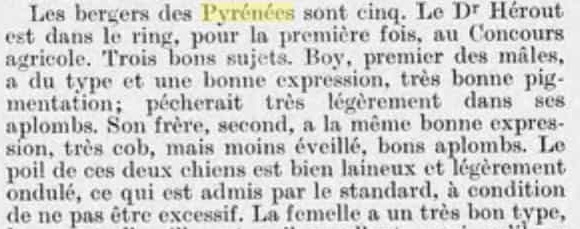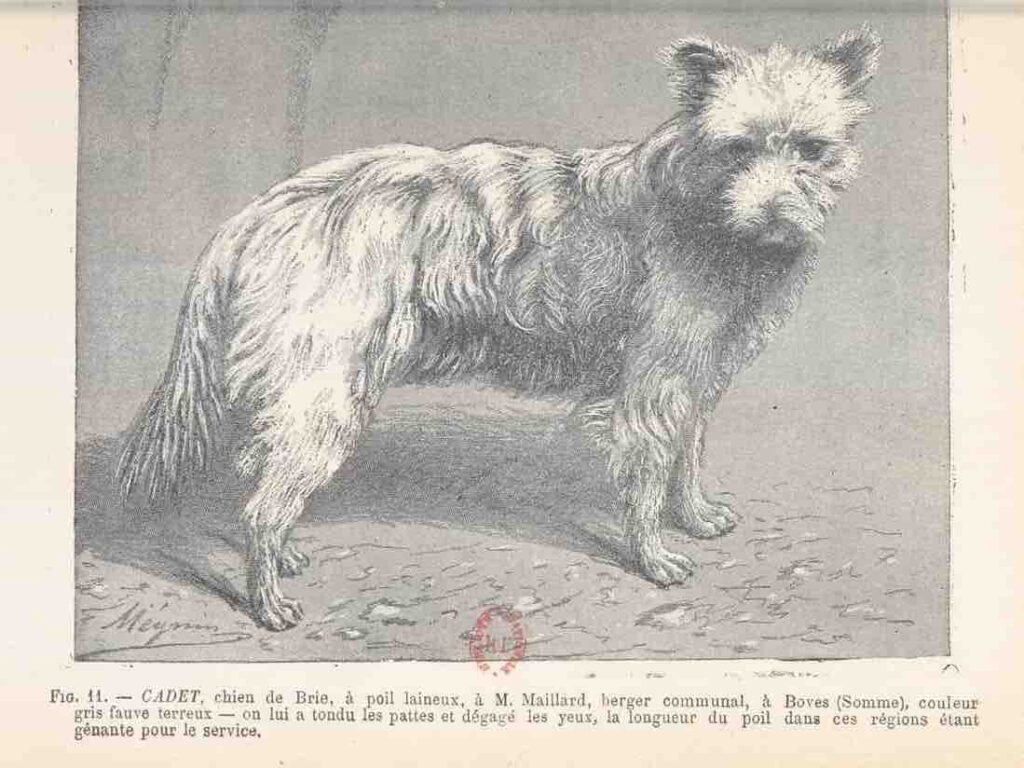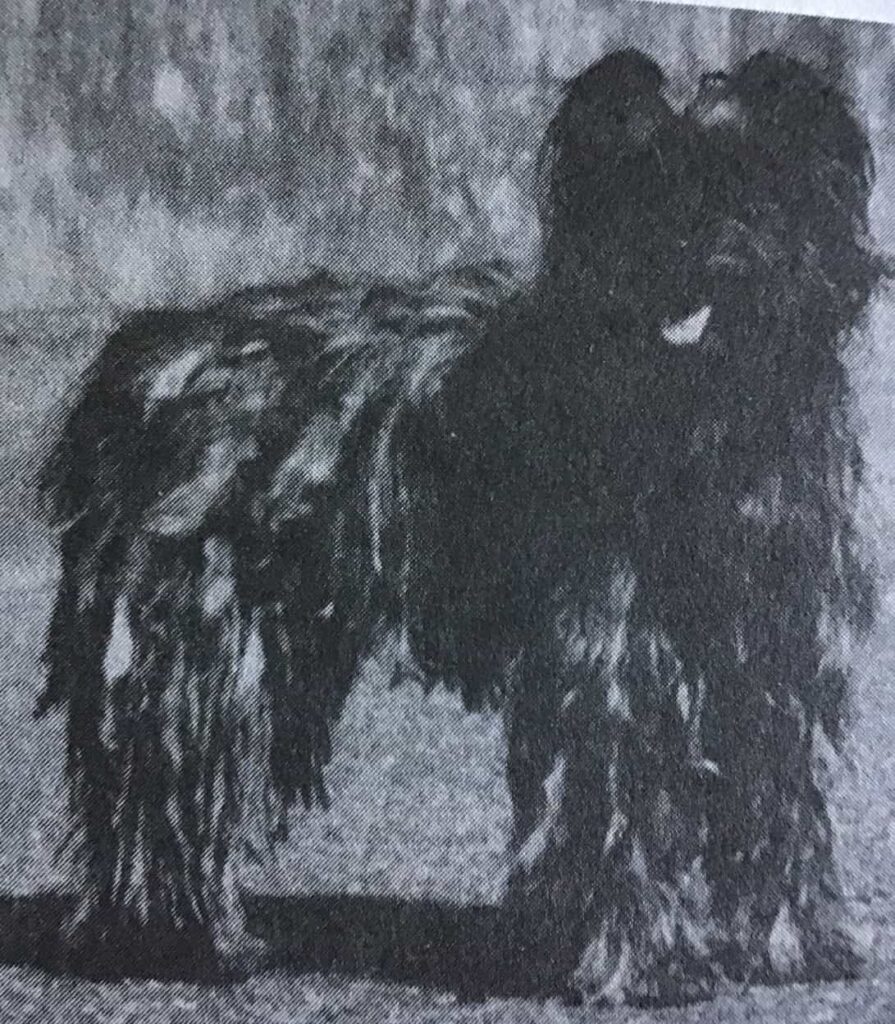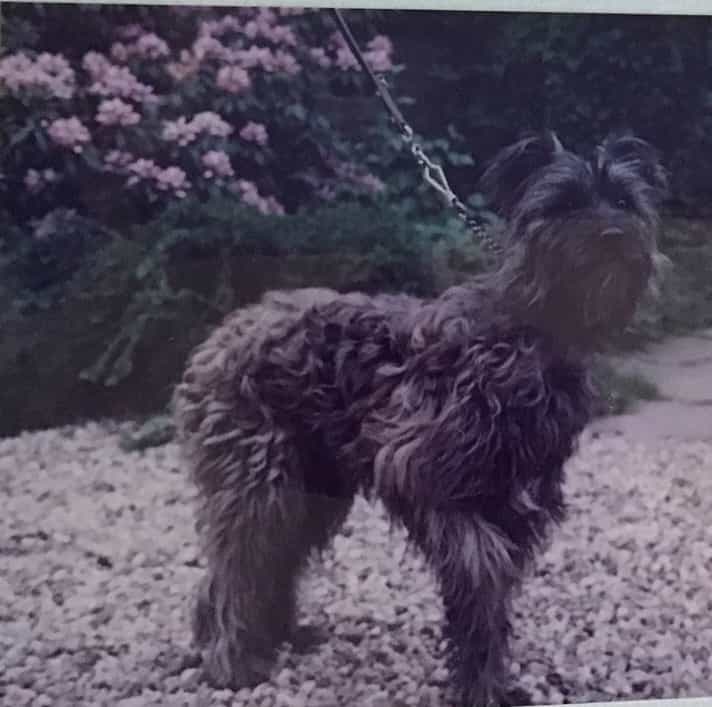How to avoid the untraditional „cadenettes“?
By traditional pyrenean pairings!
By avoiding an over-production of wool, You will avoid automatically the „cadenettes“ – Paul Mégnin – for instance – comments the few BdP exposed at the „Concours Général Agricole“ in Paris during march 16 – 18 1934 (in: „L’Éleveur“, 3/25/1934):
„…Le poil de ces deux chiens est bien laineux et légèrement ondulé, ce qui est admis par le standard, à condition de ne pas être excessif.“
Photo Comment of Paul Mégnin 1934:

Pierre Mégnin (the father of Paul) shows in the 1890ies a „Briard laineux“, whose hair is cut on the legs and at the face. The reason for this procedure: The long hair in these regions restrain the dog’s efficiency. Some years later on, the Briard-breeders changed the direction: They made crossings with the Beauceron in order to obtain less wooly Briards (the Beauceron-type working very often together with the Briards-Type at the same flock, this fact shows us that the shepherds often made this crossing). In the late 1890ies, the official breeders of Briards made an excellent change of direction because the future in that breed belonged to this new type of coat. This kind of breeding was practiced traditionally in the Pyrénées.
Photo Briard laineux / wooly Briard with cut hairs:

Mansencal 1971 mentions the „sur-production de laine“ = excess of wool, which he eliminates with a metallic comb; remember Paul Mégnin 1934: „…à condition de ne pas être excessif.“ Instead of combing out the overrun of wool, the better way for a breeder should be to make pairings which avoid genetically, not mechanically an over-production of wool. These pairings are the traditional ones in the Pyrénées (see part 3 coming soon).
Photo Mansencal 1971:

Mansencal himself made often this traditional type of pairing and obtained the highest quality in phenotype ever seen in the breed since those wonderful dogs coming from the kennel „des Gaves“ since 1915 until the early 1930ies (see part 4 coming soon). From 1978 to the end of his career, Mansencal abandoned the combing out of his dogs and acted following the principle: Wool to go… Besides Isba, Orme is another terrific example for his new and the the standard counteracting „woolly“ method:
Photo Orme:

By the way: Rubiette de l’Estaubé, an offspring of the pairing Orme x Isba, showed already as puppy the heavily undulated coat which is not consistent with the standard, even in its current edition: Défaut grave = poil frisottant; défaut éliminatoire = poil frisé.
Photo Rubiette:

1971, Mansencal writes:
… N’OUBLIANT AUCUNE MÈCHE …
1978, Mansencal does the pure opposite:
… N’ÉCARTANT AUCUNE MÈCHE …
Mansencal made a blatant and radical rupture with the then valid Standard. 20 years later, the normative force of the facts created by Mansencal since 1978, entered the new version of the standard – counter-acting the whole pyrenean tradition!
Those people who show the unconscious or even conscious act of volition not to take note of the contradiction between
(Standard 1926-1998 > Paul Mégnin 1928 > Mansencal 1971) < > (Mansencal 1978 > Standard 1998),
those people are afflicted with a cognitive dissonance.
Celles et ceux qui ne VEULENT ni voir ni reconnaître ni discuter la contradiction entre
(Standard 1926-1998 > Paul Mégnin 1928 > Mansencal 1971) < > (Mansencal 1978 > Standard 1998),
celles-ci et ceux-là souffrent d’une dissonance cognitive.